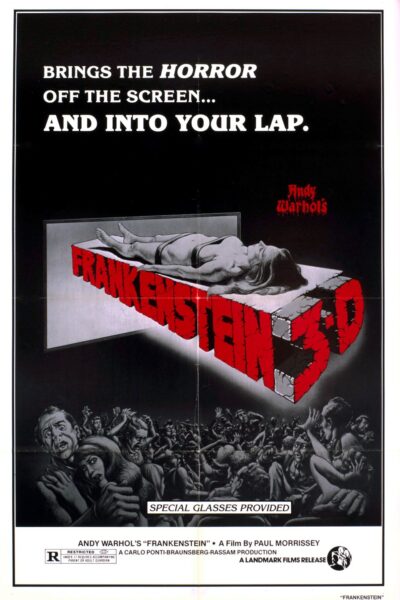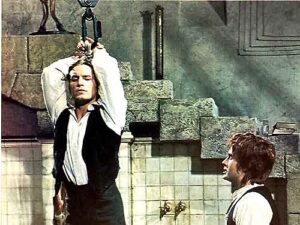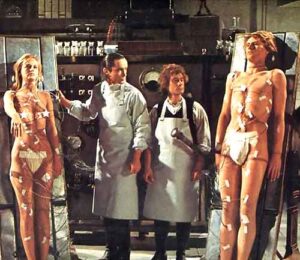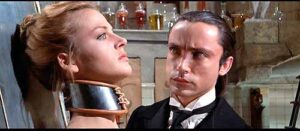It’s taken some time, but this 1973 film is now known to the world as FLESH FOR FRANKENSTEIN, its intended title, and not ANDY WARHOL’S FRANKENSTEIN, the moniker by which it was previously identified. Warhol in fact had little influence on the film outside lending his name to it, with the true auteur being the late Paul Morrissey.
Initially exhibited in 3-D, FLESH FOR FRANKENSTEIN was an Italian production, filmed at Italy’s Cinecitta Studios and employing a roster of local talent that included special effects ace Carlo Rambaldi and second unit director Antonio Margheriti (who’s often credited, wrongfully, as co-director). The film was followed in 1974 by BLOOD FOR DRACULA, which utilized many of the same cast and crew (and which was likewise known for many years under a different title: ANDY WARHOL’S DRACULA).
The setting is Serbia, where Baron von Frankenstein (Udo Kier), a mad scientist, resides in a gothic castle with his wife, the Baroness Katrin (Monique van Vooren), and two young children. The baron is using human cadavers as the raw material for scientifically created male and female zombies, with which he intends to sire a Serbian master race. Frankenstein’s major problem, that he can’t find a suitable male companion for his already-extant female zombie (Dalila Di Lazzaro), appears to be solved when he stumbles upon a good-looking farm boy (Srdjan Zelenovic).
The baron’s assistant Otto (Arno Juerging) decapitates the farm boy with garden shears, with the baron promptly taking the head back to his laboratory and sewing it onto a male torso. Frankenstein also ecstatically fondles the innards of, and has sex with, the female torso, informing his assistant that “to know death, Otto, you have to fuck life in the gall bladder!”
The baroness, meanwhile, starts up an affair with the farm boy’s friend Nicholas (Morrissey’s own Frankenstein’s monster Joe Dallesandro), who’s remarkably nonchalant about his pal’s untimely demise. This twosome is joined by the baron and the monster couple, creating a wholly bizarre family dynamic. The baroness tries to extend this dynamic by seducing the male monster, while Otto attempts to have his way with the female. Both attempts fail, and lead to an all-out slaughter-thon.
Obviously this film’s relationship with the FRANKENSTEIN dreamed up by Mary Shelley in 1818 is tenuous. Morrissey filched select elements from the novel, and the imagery of many of its pre-1973 film adaptations, but his conception is pretty unique (and influenced a subsequent film, 1991’s THE LAST FRANKENSTEIN/RASUTO FURANKENSHUTAIN).
Equally unique is the cinematic treatment, which is self-conscious and affected—read: arty, with mirror reflections and stately wide shots predominating—yet revels unashamedly in gore (with more than one depiction of exposed innards thrust directly into the camera to accentuate the 3-D effect), nudity and a healthy sense of the ridiculous. The latter element, evident in the bombastic score by Claudio Gizzi and various outré touches (like the noisy slurping sounds heard during a sex scene), adds a powerful sense of camp, an element Morrissey utilized in the manner of contemporaries like Ken Russell and John Waters (another comparison would be the George Kuchar/Curt McDowell underground epic THUNDERCRACK!, with the major difference being that Morrissey’s film is actually entertaining).
The outrageously straight-faced performers, who deliver lines like “I have no-one, just a laboratory and a dream!” with zero dramatic affectation, contribute mightily to Morrissey’s aesthetic. In the title role Udo Kier quite adequately sets the tone, dialing up the theatricality and delivering lengthy monologues in a German accent that’s nearly indecipherable, which seems at least partially intentional on the part of his director.
Vital Statistics
FLESH FOR FRANKENSTEIN (a.k.a. ANDY WARHOL’S FRANKENSTEIN)
Compagnia Cinematographica Champion
Director: Paul Morrissey
Producer: Andrew Braunsberg
Screenplay: Paul Morrissey
Cinematography: Luigi Kuveiller
Editing: Franca Silvi, Jed Johnson
Cast: Joe Dallesandro, Monique Van Vooren, Udo Kier, Arno Juerging, Dalia Di Lazzaro, Srdjan Zelenovic, Nicoletta Elmi, Liv Bosisio, Cristina Gaioni, Carla Mancini, Marco Liofredi, Fiorella Masselli, Rosita Torosh, Imelde Marani




